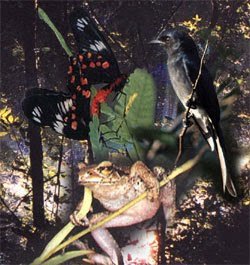Ravana Ella( Ravana Falls)

Peradeniya Botanical Garden
Maduru Oya National Park
Horton Plains National Park
Wild Parks
Wild parks in Sri lanka
Sri Lanka has a rich and exotic variety of wildlife and a long tradition of conservation rooted in its 2,230 year old Buddhist civilization. The following are the most important sanctuaries in terms of attractions, accessibility and availability of facilities.
Animal Sanctuaries
The animals to be seen in Sri Lanka's national parks include elephant, leopard, sloth bear, sambhur, deer and monkeys, wild buffalo, wild boar (pig), porcupine, ant-eater, civet cat, jackal, mongoose, loris (unique to sri Lanka) several varieties of lizards, squirrels, reptiles and amphibians. Each park however has its own specialties.
Hikkaduwa
Hakgala Botanical Garden
t was the site initially for experiments with cinchona whose bark yielded quinine, esteemed as a tonic and febrifuge. Quinine at that time was widely used as a specific for malaria. This was perhaps the reason for the popularity of and tonic in these parts - quinine being the principle ingredient of tonic water.The cool, equable climate of the hakgala area, whose mean temperature is around 60 degrees Fahrenheit, encouraged the introduction of suitable temperate zone plants, both ornamental and useful. These included conifers and cedars from Australia, Bermuda and Japan, and cypresses from the Himalayas, china and as far a field as Persia, Mexico and California. New Caledonia gave Hakgala a special variety of pines and there are specimens of this genus from the canary Island as well.An English oak, introduced around 1890, commemorates the "hearts of oak" of Britain's vaunted sea power, and there is a good-looking specimen of the camphor tree, whose habitat is usually in regions above 12,000m.If you have left your heart in an English garden, you will surely find it again in Hakgala's Rose garden. where the sights and scents of these glorious blooms can be experienced in their infinite variety. From there it is a quiet stroll from the sublime to the exotic sophistication of the orchid House. A special attraction here is the verity of montane orchids, many of them endemic to Sri Lanka.It would be in the worst possible taste to describe the Fernery as a collection of "vascular cryptograms" But that is how the dictionary describes the plant whose delicate fronds conjure up visions of misty grottoes, lichen-covered stones and meandering streams. The Fernery at Hakgala is a shady harbour of many quiet walks, in the shad of the Hakgala Rock, shaped like the jawbone of an elephant, from which the place gets its name. Sri Lanka's ferns are well represented here, as are those of Australia and New Zealand.Hakgala is a temperate hill-country garden where also the languid low-country lotus and water lily floats in their serene loveliness. Pinks and blues emerging from a flat- floating background of lush leaves, recall the calm of yellow-robed monks, white-clad, devotees and flickering oil lamps.In time, the highlands bracing breezes dispel the languor of lotus land and even cause a shiver as a temperature lowers. The Hakgala Botanical Gardens is one of the lovely contrasts of Sri Lanka, a home to plants and trees from around the world, making them seem to be part of the scenic beauty.How to get to Hakgala: The nearest railway station is at Nanu Oya, from where there are buses or taxis on the Nuwara Eliya to Badulla road to Hakgala.
Water Falls in Sri Lanka
Diyaluma Falls( skein of water)

Bopath Ella (Bo-leaf fall)












